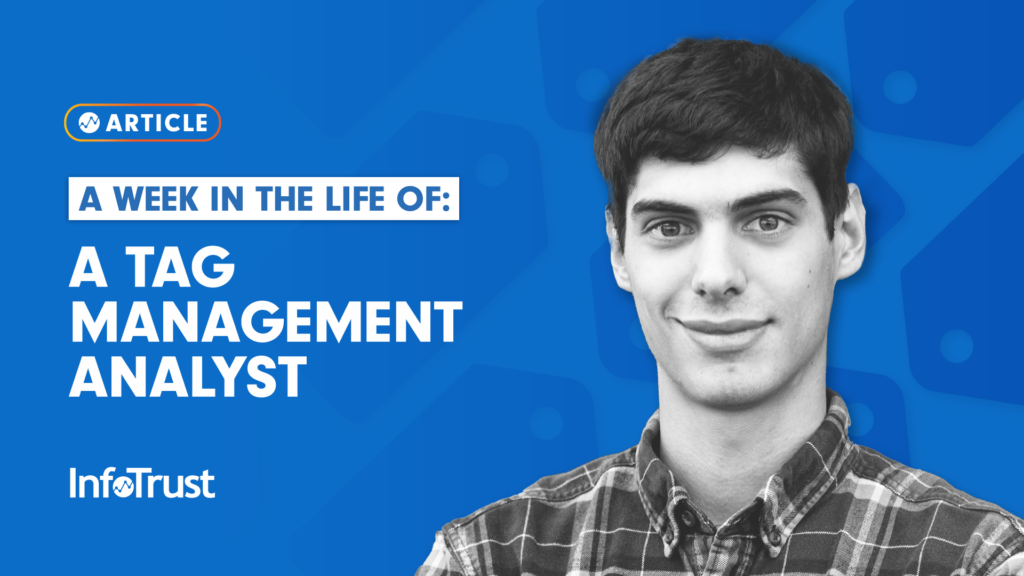Hello there! I’m Stephanie, a recruiter here at InfoTrust. I’m back with another edition of a Week in Life of Series, where our recruiting team will meet with various InfoTrusters to learn more about what a week in their role looks like. This time I sat down with Facundo Marron to learn what a week looks like for him as a tag management analyst on our Consumer Data Governance team.
SH: Thanks, Facundo, for taking the time to talk with me about your role! Tell me, how long have you been at InfoTrust?
FM: I’ve been at InfoTrust for three years. I started in the digital analytics consultant role, and for the last six months, I’ve been a tag management analyst.
SH: What interested you in the tag management analyst role?
FM: When I started in the digital analytics consultant role, the Consumer Data Governance team hadn’t been created yet. There was a lot of tag management work that I was doing in my role, and in general, there can be a lot of overlap between the two teams with this type of work. I noticed that was the type of work I was enjoying the most in my day-to-day, so I started having chats with a few people on that team and with my manager as well. It seemed the tag management analyst role suited me better with the type of work I like doing.
SH: How would you describe the tag management analyst role?
FM: There are a couple of high-level elements of the role. One of the main things we need to be aware of is regarding all of the rules and regulations surrounding consent and privacy more generally, so there’s GDPR and CCPA as examples. As a team, we are seeking to understand all of the regulations and how we need to react to them—and what sort of recommendations we make to clients. They often ask us about how to set up their pixels, when those should fire and when those should not fire, and what data they are capturing. We’re paving the way and leading our clients in a privacy-centered way while still getting as much useful information as we can. That’s a big general focus of the team. That does tie into the implementation aspect. A lot of the day-to-day is in various tag management systems, setting up tags, testing, and validation to make sure they are firing when they are supposed to—and a lot of the privacy regulations play into the implementation. Clients have a consent management platform that controls what is allowed to fire and what is not (it’s what makes the cookie banner show up). I put the cookie banner there, and when the user chooses to allow cookies or not, I ensure those preferences are followed and respected.
SH: Finish this sentence: Someone would enjoy the tag management analyst role, if they enjoy …
FM: Troubleshooting and validating/testing. You’re always troubleshooting when setting up the tag, in a sense, but it’s a lot of playing around in the tag management system, how it interacts with all the data points on the site, which ones you can pull, and then getting used to using the developer tools that are available in browsers. It’s not as technical as a developer role, but it is technical troubleshooting and you do have to have a decent understanding of how the network requests work; for example, when a pixel is on a site, what is it doing, all the different tools, and how you troubleshoot them in different ways. There are a few main tools and tricks, but sometimes you have to get a bit more creative. It requires minor development work/code writing to retrofit what’s on the site to what the tag is expecting. Sometimes there’s a lot of manipulation to change the way things are formatted that requires some coding chops—like knowing JavaScript and how the internet works at a high level. Expect to spend a lot of time with the developer tools and looking at the console to see what error messages show up.
SH: What does a typical week look like for you?
FM: 60-70% is more technical work. It can depend on the client. Some clients have a project manager and I’m assigned tickets and handle those. Meanwhile, some clients have less tickets, and it’s more advising on consent (there are more meetings and less technical work). In some other cases, they are larger engagements and I’m focused on the nitty gritty. As far as general meetings go, I meet weekly, if not more, with clients. There’s a number of internal meetings like general all-company meetings, a CDG team meeting where we connect on things going on in the industry and how we want to approach them, technical working sessions where someone on the team might teach us something new, and a 1-on-1 with my manager. When I meet with my manager, we catch up on personal things—but also it’s a general temperature check on how things are going at work. We touch base on my priorities for the quarter and what I’m working on, any time off requests so we can make sure clients are covered, and general career aspirations and where I want my career to go. I also have time set aside for education, for example, if I’m learning a new tag management system, that falls more into the 60-70% technical work.
Join the Team
If there’s one thing we can promise at InfoTrust, it’s that no two days are the same. The tag management analyst role offers a great variety of technical and client-facing work, mixed in with the ability to contribute to training and educating your peers, joining awesome internal groups, and more. We are currently hiring for this role and many others. InfoTrust offers medical, dental, and vision for employees and dependents; 401k with generous match; unlimited PTO; flex work schedules; and much more. Visit www.infotrust.com/careers to view our open roles and apply!


